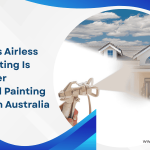Choosing the best house paint for a coastal homes in Hobart isn’t just about colour or brand. It’s about matching product performance to a harsh, salty, and changeable environment. If you live near the Derwent or on one of Hobart’s exposed headlands, your exterior paint system has to resist salt spray, strong UV, wind-driven rain and the damp cycles that come with Tasmanian weather.
This guide explains why coastal homes need specialist products, what features to look for, the product families pros and cons, and the non-negotiable preparation steps before a long-lasting finish.
Why Coastal Homes in Hobart Need Specialised Exterior Paint
Hobart’s coastal conditions accelerate common paint failure modes. Salt-laden air speeds up corrosion on metal flashings and fasteners, abrasive winds increase surface wear, strong UV breaks down binders and pigments (leading to fading and chalking), and frequent damp spells promote mould and mildew growth. Left unchecked, these forces cause peeling, blistering, corrosion stains and shortened repaint cycles which means higher lifetime costs for homeowners.
Hiring experienced house painters in Hobart or talking to specialist painting contractors at the quote stage helps you specify products and application methods that withstand these stresses, not just prettier swatches.
Materials at Risk
Coastal exposure doesn’t affect all materials the same. Key elements to inspect and protect:
- Weatherboard cladding (timber & fibre cement): Prone to moisture ingress and paint failure where laps collect salt.
- Timber trims and eaves: Movement + dampness causes cracking and peeling.
- Metal flashings, gutters and balustrades: Salt accelerates corrosion and undermines coatings.
- Masonry (render & brick): Salt crystallisation can cause surface spalling and efflorescence.
- Joinery and external doors: Frequent use + exposure needs durable, hard-wearing finishes.
What to Look for in the Best Exterior Paint for Coastal Homes
Not all exterior paints are created equal. When specifying a system for a Hobart coastal property, prioritise these features:
- 100% acrylic exterior systems: Acrylics offer superior UV resistance, elasticity to accommodate substrate movement, and adhesion to a range of surfaces. For most timber, fibre cement and masonry exteriors, a high-quality acrylic exterior paint is the sweet spot.
- Salt-resistant / marine-grade additives: These formulations include corrosion inhibitors and binders that resist salt penetration and reduce underfilm corrosion on adjacent metalwork. Choose marine-grade coatings for constantly exposed metalwork.
- Anti-mould & mildew properties: Biocides in the finish reduce fungal growth on north-facing or shaded walls where damp lingers, a common issue in Hobart’s pockets of humidity.
- UV & colourfastness: Look for topcoats with high-performance pigments and stable binders; they hold colour longer and reduce chalking.
- Breathability vs waterproofing: Older timber and solid masonry need breathable systems that allow trapped moisture to escape. Overly waterproof systems can trap moisture and accelerate decay. Match the system to the substrate.
- Sheen choice: Flat hides imperfections but can show dirt; low-sheen offers a balance of durability and cleanability; gloss is easiest to wash but highlights surface defects. For coastal homes, low-sheen or satin often gives the best mix of performance and aesthetic.
Top Product Types & Local Favourites (What Pros Recommend)
Below are common product families available across Australia, with quick pros/cons and where we’d typically use them:
1. Dulux Weathershield / Weathershield Exterior
- Pros: Proven UV resistance, good weatherproofing and long warranties.
- Cons: Premium price; performance depends on correct prep and coats.
- Typical applications: Weatherboard, fibre-cement, and full exterior repaints where longevity matters.
2. Haymes Solashield / Solashield Exterior
- Pros: Formulations emphasise salt and sun protection; strong colour retention.
- Cons: Slightly fewer colour-matching outlets in some regions; trade application still recommended.
- Typical applications: Coastal homes with direct ocean exposure, walls and trim.
3. Taubmans All Weather
- Pros: Good mould resistance and trade support; competitively priced.
- Cons: May require more frequent maintenance in the most exposed sites.
- Typical applications: Mid-range exterior systems, rental properties or larger projects where value is key.
4. Marine-Grade Coatings
- Pros: Outstanding corrosion and salt performance for metalwork, structural steel and boats.
- Cons: More expensive; often requires professional application and specific primers.
- Typical applications: Gutters, flashings, external metal railings, and marine-facing trim.
How to choose between brands: base your decision on substrate type (timber vs metal vs masonry), your maintenance budget (premium products extend repaint cycles), and how exposed the site is to wind and salt. Talk to painting contractors for local, site-specific recommendations.
Surface Preparation & Primer: The Non-Negotiable Steps
The best house paint finish fails without proper prep. It’s always more important than the “fancy paint” choice. Coastal surfaces demand thorough cleaning to remove salt deposits and contaminants, rust treatment and removal on metal, sanding of loose coatings, and stabilising rotten or friable timber. For primers:
- Use corrosion-inhibiting primers on metalwork and fasteners.
- Use acrylic primers/undercoats for timber and fibre cement to promote adhesion.
- Use moisture-tolerant masonry primers or breathable renders for brick and render.
Expect a properly specified exterior system to include a primer + two topcoats, with dry-film thickness targets set to the manufacturer’s recommendation; more coats or thicker films on the most exposed elements will extend life and performance.
Application Tips & Seasonal Timing for Hobart
Timing matters more here than colour trends. Hobart’s best windows for exterior painting are periods of settled, mild weather, when it’s dry, relatively calm, and temperatures sit comfortably within the paint manufacturer’s recommended range. Avoid painting on windy days that blow salt spray onto wet paint, and don’t paint just before a forecasted run of heavy rain.
Practical timing rules:
- Aim for late spring to early autumn for the most reliable dry spells.
- Check the 48–72 hour forecast: you want no rain and moderate temps during and for a day after application.
- Avoid painting immediately after a long wet period; surfaces must be dry and salt-free.
When hiring pros, ask house painters in Hobart about their seasonal workload and how they schedule coastal jobs, experienced teams plan around tides, wind patterns and local microclimates.
Wind & Overspray Precautions for Coastal Locations
Coastal sites complicate spray application. Even on a calm-seeming day, sea breezes and gusts can carry overspray to windows, vehicles and neighbouring properties.
Key precautions painting contractors should take:
- Masking & protection: Fully mask and sheet windows, vents, and soft landscaping. Secure covers against gusts.
- Scaffold orientation: Position scaffolding and screens to block prevailing winds; use windbreak sheeting where permitted.
- Spray technique: Use lower-pressure settings and closer passes, or switch to brush/roller for exposed areas if wind is unpredictable.
- Neighbour notices: Alert neighbours to planned spray work and cover vulnerable surfaces. It’s part of professional site care, a good sign when you’re hiring painting contractors.
Maintenance Plan: Cleaning, Touch-Ups & Repaint Triggers
A coastal paint system is a living thing, it needs care. A simple maintenance plan significantly increases longevity and appearance.
Recommended routine:
- Annual visual check: look for blistering, rust stains, heavy chalking, mould streaks or failed sealants.
- Gentle wash: every 12–24 months, wash exteriors with a low-pressure rinse and a mild detergent to remove salt and surface grime. Avoid high-pressure washers on older timber.
- Targeted touch-ups: spot-prime and touch small chips and scratches as they appear; this prevents salt and moisture from finding a way under the film.
- Repaint triggers: consider repainting when widespread chalking reduces protection, when over 20% of coated areas show adhesion failure, or when protective finishes have reached their expected life.
Householders who sign a maintenance plan with their contractors usually see the best outcomes. It’s a small yearly cost that defers big repaint bills.
Cost vs Lifespan: Budgeting for Coastal Protection
Buying the cheapest paint and doing the minimum prep often costs more over time. Think of exterior painting as an insurance policy: spend smartly now to extend the interval between full repaints.
Comparison snapshot:
- Budget systems (lower upfront cost): May need repainting every 5–7 years on exposed coastal walls. Good short-term fix, higher lifetime cost.
- Premium acrylic systems + professional application: Typically extend the interval to 8–12 years (or more on sheltered aspects). Higher initial spend, lower total cost of ownership.
Case example (simplified): A premium system that costs 30% more upfront but doubles the repaint interval effectively halves yearly painting cost. That’s when investing in the best house paint and hiring reputable house painters in Hobart makes clear financial sense.
When a Premium Product + Pro Application Pays Off
Choose premium products when your home has high exposure, valuable timber, or a tight maintenance timetable (e.g., heritage homes or investment properties). Professional application matters: correct prep, correct primer, correct film build and competent finishing are what turn product specs into real-world longevity.
Colour & Finish Choices that Work on Coastal Homes
Colour affects longevity and maintenance:
- Darker colours absorb more UV and heat; they can fade and show chalking faster in exposed sites.
- Lighter neutrals reflect heat, show less chalking, and are often easier to maintain visually.
- Accent trims & protectors: use tougher enamels or marine-grade coatings for balustrades, metalwork and decks. These elements get the most wear and should use harder-wearing finishes.
Balance aesthetics with practicality. Your house painters in Hobart can supply swatches and mock-up panels to test colour performance on-site before committing.
Quick Decision Checklist Before You Call a Pro
Use this 6-point checklist to prepare for quotes and to help your chosen contractor deliver the right system:
- Identify surface type (timber, fibre cement, masonry, metal).
- Note any visible corrosion on metalwork or fasteners.
- Record the previous paint type if known (acrylic, oil, alkyd).
- Check for immediate moisture issues (rising damp, leaks).
- Set a budget and an expected maintenance plan.
- Pick ideal timing windows (avoid winter/wet spells).
FAQs
Q: How long will exterior paint last on a Hobart coastal home?
With premium acrylic systems and pro prep, expect roughly 8–12 years on sheltered walls; exposed elements may need attention sooner.
Q: Is a marine paint necessary for my coastal house?
Only for metalwork or areas in constant salt spray; general walls usually do better with high-quality exterior acrylics.
Q: How soon after painting can coastal homes be exposed to sea spray?
Allow full cure as per the manufacturer (commonly 7–14 days for topcoats); avoid heavy spray and storms during that period.
Q: What maintenance keeps paint looking good near the sea?
Annual visual checks, gentle washing every 12–24 months, and spot touch-ups for chips and scratches.
Q: Can I spray paint in a coastal location?
Yes, with strict wind, masking and scaffold controls. Otherwise, choose a brush/roller where wind risk is high.
Q: Should I hire local house painters in Hobart?
Yes, local teams understand microclimates and are more likely to specify systems that actually work for Hobart’s coast.
Protect Your Coastal Home with the Best House Paint in Hobart
Your home’s first line of defence against Hobart’s coastal wind, salt, and rain is the quality of its exterior paint. Don’t leave it to chance, trust skilled house painters Hobart residents rely on for lasting results. At Dyson Painters, our expert team understands how to select and apply the best house paint to withstand the unique challenges of seaside living. From preparation to the final coat, we ensure every detail is perfected for beauty and durability. Secure your investment today, contact our professional painting contractors and give your coastal home a finish built to last.





